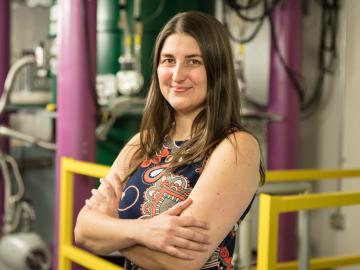
Filter News
Area of Research
- Advanced Manufacturing (1)
- Biological Systems (1)
- Biology and Environment (45)
- Computational Engineering (1)
- Computer Science (2)
- Energy Science (14)
- Fusion and Fission (3)
- Isotopes (20)
- Materials (32)
- Materials for Computing (3)
- Mathematics (1)
- National Security (2)
- Neutron Science (9)
- Nuclear Science and Technology (5)
- Quantum information Science (3)
- Supercomputing (37)
News Topics
- (-) Bioenergy (37)
- (-) Frontier (23)
- (-) Isotopes (29)
- (-) Molten Salt (5)
- (-) Physics (26)
- (-) Quantum Science (24)
- (-) Space Exploration (10)
- 3-D Printing/Advanced Manufacturing (51)
- Advanced Reactors (6)
- Artificial Intelligence (34)
- Big Data (16)
- Biology (53)
- Biomedical (22)
- Biotechnology (11)
- Buildings (27)
- Chemical Sciences (31)
- Clean Water (14)
- Composites (15)
- Computer Science (67)
- Coronavirus (14)
- Critical Materials (11)
- Cybersecurity (17)
- Education (3)
- Emergency (1)
- Energy Storage (44)
- Environment (85)
- Exascale Computing (17)
- Fossil Energy (2)
- Fusion (21)
- Grid (29)
- High-Performance Computing (52)
- Hydropower (3)
- Irradiation (2)
- ITER (4)
- Machine Learning (16)
- Materials (91)
- Materials Science (48)
- Mathematics (3)
- Mercury (6)
- Microelectronics (2)
- Microscopy (22)
- Nanotechnology (26)
- National Security (28)
- Neutron Science (62)
- Nuclear Energy (37)
- Partnerships (24)
- Polymers (14)
- Quantum Computing (17)
- Security (13)
- Simulation (29)
- Software (1)
- Statistics (1)
- Summit (20)
- Transportation (46)
Media Contacts

Since the 1930s, scientists have been using particle accelerators to gain insights into the structure of matter and the laws of physics that govern our world.

A new tool from Oak Ridge National Laboratory can help planners, emergency responders and scientists visualize how flood waters will spread for any scenario and terrain.

A team of scientists has for the first time measured the elusive weak interaction between protons and neutrons in the nucleus of an atom. They had chosen the simplest nucleus consisting of one neutron and one proton for the study.

Scientists at the Department of Energy’s Oak Ridge National Laboratory have created a recipe for a renewable 3D printing feedstock that could spur a profitable new use for an intractable biorefinery byproduct: lignin.

Scientists from Oak Ridge National Laboratory performed a corrosion test in a neutron radiation field to support the continued development of molten salt reactors.

Leah Broussard, a physicist at the Department of Energy’s Oak Ridge National Laboratory, has so much fun exploring the neutron that she alternates between calling it her “laboratory” and “playground” for understanding the universe. “The neutron is special,” she said of the sub...
Physicists turned to the “doubly magic” tin isotope Sn-132, colliding it with a target at Oak Ridge National Laboratory to assess its properties as it lost a neutron to become Sn-131.

Three researchers from the Department of Energy’s Oak Ridge National Laboratory have been elected fellows of the American Physical Society (APS). Fellows of the APS are recognized for their exceptional contributions to the physics enterprise in outstanding resear...

Scientists at the Department of Energy’s Oak Ridge National Laboratory used neutrons, isotopes and simulations to “see” the atomic structure of a saturated solution and found evidence supporting one of two competing hypotheses about how ions come
Scientists studying a valuable, but vulnerable, species of poplar have identified the genetic mechanism responsible for the species’ inability to resist a pervasive and deadly disease. Their finding, published in the Proceedings of the National Academy of Sciences, could lead to more successful hybrid poplar varieties for increased biofuels and forestry production and protect native trees against infection.


